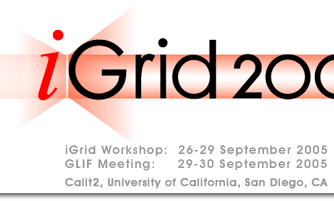News Releases
DALSA Origin Footage Featured in First International Real-time Collaboration on 4K Digital Cinema Content
San Diego, California, and Tokyo, Japan, September 28, 2005 - Footage captured from the DALSA (TSX: DSA) Origin® digital cinematography camera was featured yesterday in the first international demonstration of real-time collaborative 4K digital dailies workflow in San Diego at iGrid 2005, a workshop and symposium that attracts the world’s leading experts in grid computing and high bandwidth networking.
The trans-Pacific demonstration, which took place simultaneously at the California Institute for Telecommunications and Information Technology (Calit2), University of California, San Diego (UCSD), and at the digital cinema laboratory at Keio University in Tokyo, simulated a multi-site digital dailiesscenario, in which members of a production team, typically the cinematographer, director, and producer, can collaborate on a motion picture production even if they are in different locations.
The iGrid experiment marked the world’s first international real-time collaboration on motion picture content at 4K resolution. 4K (roughly equivalent to 4000 horizontal pixels) is the high resolution digital image format that is already being used for post-production on a growing number of major Hollywood films and will also be widely employed for future digital cinema theatrical distribution under new specifications proposed by Digital Cinema Initiatives, LLC, a consortium of the seven major Hollywood studios.
The iGRID 4K Demonstration
At Keio University in Japan, uncompressed 4K digital footage from the Origin camera was fed into a Silicon Graphics Prism™ visualization system from SGI (NYSE: SGI) running The Pixel Farm PFPlay software. The operator in Japan created a playlist from several 4K uncompressed clips on the SGI® system using Pixel Farm PFPlay software. The 4K data was then encoded using an NTT JPEG 2000 encoder to approximately 200Mbps and sent from Japan over fiber optic IP networks to San Diego where it was decoded and played back on a prototype Sony SXRD 4K (3840 x 2160) projector installed at Calit2’s new 200 seat theatre.
The 4K digital content from the DALSA camera was then edited in the iGrid conference auditorium and the modifications were sent back immediately in real-time to Tokyo for final conforming of the 4K data. The newly generated modified playlist was once again compressed and re-sent, decoded and played back in 4K to the audience in San Diego.
To read the entire article, see: dalsa.com/news/news.asp?itemID=216


